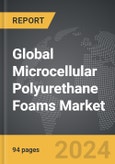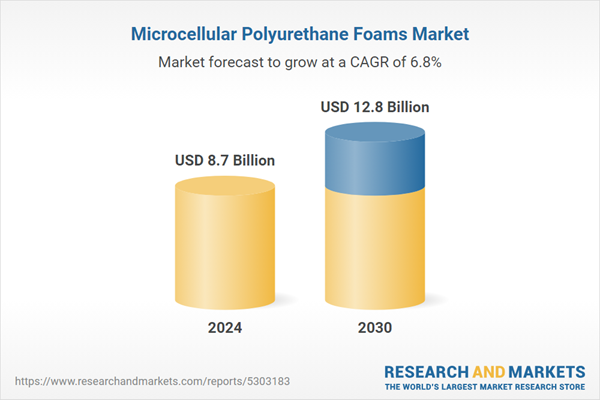Global Microcellular Polyurethane Foams Market - Key Trends and Drivers Summarized
How Are Microcellular Polyurethane Foams Used Across Industries?
Microcellular polyurethane foams are versatile materials characterized by their low density, excellent cushioning properties, and durability. These foams are used across various industries, including automotive, consumer goods, electronics, and construction, for applications that require shock absorption, insulation, and comfort. In the automotive sector, microcellular polyurethane foams are commonly found in seating, armrests, and headrests, providing comfort and reducing the weight of vehicle interiors. Additionally, these foams are used in the manufacturing of gaskets and seals, where their flexibility and resilience help improve the overall performance and longevity of the components. In the electronics industry, microcellular polyurethane foams are used for cushioning and protecting sensitive components from impact and vibrations. Their ability to provide both thermal and acoustic insulation also makes them an ideal material for consumer goods, such as headphones and packaging materials. The construction industry employs microcellular polyurethane foams for insulation and sealing purposes, helping to improve energy efficiency in buildings by reducing air leakage and providing superior thermal insulation.What Innovations Are Shaping the Microcellular Polyurethane Foams Market?
Advances in the production processes and formulations of microcellular polyurethane foams are shaping the market, particularly in terms of environmental sustainability. Manufacturers are increasingly focused on developing foams that use bio-based raw materials, which reduce the reliance on petroleum-based products and lower the carbon footprint of the production process. These eco-friendly alternatives are gaining popularity as industries seek to comply with environmental regulations and meet consumer demand for sustainable products. Another key innovation in the microcellular polyurethane foams market is the development of high-performance foams that offer enhanced durability, chemical resistance, and temperature stability. These properties are particularly important in applications such as automotive gaskets, where components are exposed to extreme conditions. Additionally, advancements in additive manufacturing and 3D printing technologies are enabling manufacturers to produce microcellular polyurethane foams with more complex geometries and tailored properties, expanding their use across new industries and applications.How Do Market Segments Define the Growth of Microcellular Polyurethane Foams?
Types of microcellular foams include high-density and low-density foams, with high-density foams being preferred in automotive and industrial applications due to their superior strength and durability. In terms of application, the automotive sector represents the largest market segment, driven by the demand for lightweight, comfortable materials in vehicle interiors. Other significant applications include electronics, where the foams are used for cushioning and insulation, and the consumer goods sector, where they provide cushioning in footwear and furniture. Regionally, North America and Europe dominate the microcellular polyurethane foams market due to strong demand from the automotive and construction industries. However, the Asia-Pacific region is expected to witness rapid growth, driven by the expanding automotive manufacturing base in countries like China and India, as well as increasing construction activities in the region.What Factors Are Driving the Growth in the Microcellular Polyurethane Foams Market?
The growth in the microcellular polyurethane foams market is driven by several factors, including the increasing demand for lightweight and durable materials in the automotive and electronics industries, the growing emphasis on energy efficiency in construction, and advancements in foam production technology. The automotive industry’s shift towards reducing vehicle weight to improve fuel efficiency is a significant driver of demand for microcellular polyurethane foams, as these materials offer a lightweight alternative without compromising comfort or durability. Additionally, the rise in consumer demand for electronics with better shock absorption and insulation is boosting the market for microcellular foams. Environmental concerns and the development of bio-based polyurethane foams are also contributing to the market’s growth, as industries look for sustainable alternatives to traditional materials.Report Scope
The report analyzes the Microcellular Polyurethane Foams market, presented in terms of units. The analysis covers the key segments and geographic regions outlined below.Segments: Type (High-Density, Low-Density); Application (Automotive, Building & Construction, Electronics, Medical, Aerospace, Other Applications).
Geographic Regions/Countries: World; United States; Canada; Japan; China; Europe (France; Germany; Italy; United Kingdom; Spain; Russia; and Rest of Europe); Asia-Pacific (Australia; India; South Korea; and Rest of Asia-Pacific); Latin America (Argentina; Brazil; Mexico; and Rest of Latin America); Middle East (Iran; Israel; Saudi Arabia; United Arab Emirates; and Rest of Middle East); and Africa.
Key Insights:
- Market Growth: Understand the significant growth trajectory of the High-Density segment, which is expected to reach US$7.7 Billion by 2030 with a CAGR of a 7.1%. The Low-Density segment is also set to grow at 6.3% CAGR over the analysis period.
- Regional Analysis: Gain insights into the U.S. market, valued at $2.2 Billion in 2024, and China, forecasted to grow at an impressive 10.2% CAGR to reach $3.1 Billion by 2030. Discover growth trends in other key regions, including Japan, Canada, Germany, and the Asia-Pacific.
Why You Should Buy This Report:
- Detailed Market Analysis: Access a thorough analysis of the Global Microcellular Polyurethane Foams Market, covering all major geographic regions and market segments.
- Competitive Insights: Get an overview of the competitive landscape, including the market presence of major players across different geographies.
- Future Trends and Drivers: Understand the key trends and drivers shaping the future of the Global Microcellular Polyurethane Foams Market.
- Actionable Insights: Benefit from actionable insights that can help you identify new revenue opportunities and make strategic business decisions.
Key Questions Answered:
- How is the Global Microcellular Polyurethane Foams Market expected to evolve by 2030?
- What are the main drivers and restraints affecting the market?
- Which market segments will grow the most over the forecast period?
- How will market shares for different regions and segments change by 2030?
- Who are the leading players in the market, and what are their prospects?
Report Features:
- Comprehensive Market Data: Independent analysis of annual sales and market forecasts in US$ Million from 2024 to 2030.
- In-Depth Regional Analysis: Detailed insights into key markets, including the U.S., China, Japan, Canada, Europe, Asia-Pacific, Latin America, Middle East, and Africa.
- Company Profiles: Coverage of players such as BASF SE, DOW Chemical Company (The), ERA Polymers, Evonik Industries, Griswold International, Llc and more.
- Complimentary Updates: Receive free report updates for one year to keep you informed of the latest market developments.
Some of the 43 companies featured in this Microcellular Polyurethane Foams market report include:
- BASF SE
- DOW Chemical Company (The)
- ERA Polymers
- Evonik Industries
- Griswold International, Llc
- Huntsman Corporation
- Inoac Corporation
- Mearthane Products Corporation
- Rogers Corporation
- Rubberlite Inc.
- Saint-Gobain Performance Plastics
Tariff Impact Analysis: Key Insights for 2025
Global tariff negotiations across 180+ countries are reshaping supply chains, costs, and competitiveness. This report reflects the latest developments as of April 2025 and incorporates forward-looking insights into the market outlook.The analysts continuously track trade developments worldwide, drawing insights from leading global economists and over 200 industry and policy institutions, including think tanks, trade organizations, and national economic advisory bodies. This intelligence is integrated into forecasting models to provide timely, data-driven analysis of emerging risks and opportunities.
What’s Included in This Edition:
- Tariff-adjusted market forecasts by region and segment
- Analysis of cost and supply chain implications by sourcing and trade exposure
- Strategic insights into geographic shifts
Buyers receive a free July 2025 update with:
- Finalized tariff impacts and new trade agreement effects
- Updated projections reflecting global sourcing and cost shifts
- Expanded country-specific coverage across the industry
Table of Contents
Companies Mentioned (Partial List)
A selection of companies mentioned in this report includes, but is not limited to:
- BASF SE
- DOW Chemical Company (The)
- ERA Polymers
- Evonik Industries
- Griswold International, Llc
- Huntsman Corporation
- Inoac Corporation
- Mearthane Products Corporation
- Rogers Corporation
- Rubberlite Inc.
- Saint-Gobain Performance Plastics
Table Information
| Report Attribute | Details |
|---|---|
| No. of Pages | 94 |
| Published | April 2025 |
| Forecast Period | 2024 - 2030 |
| Estimated Market Value ( USD | $ 8.7 Billion |
| Forecasted Market Value ( USD | $ 12.8 Billion |
| Compound Annual Growth Rate | 6.8% |
| Regions Covered | Global |









